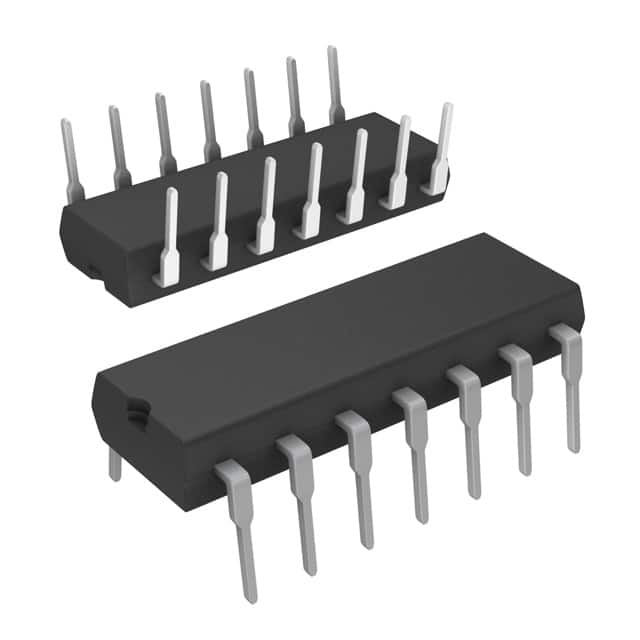MC10E1651L
Product Overview
- Category: Integrated Circuit (IC)
- Use: Digital Logic
- Characteristics: High-speed, ECL (Emitter-Coupled Logic) compatible
- Package: 28-pin PLCC (Plastic Leaded Chip Carrier)
- Essence: The MC10E1651L is a high-speed ECL-compatible integrated circuit used for digital logic applications.
- Packaging/Quantity: Available in tubes or reels, quantity depends on supplier.
Specifications
- Supply Voltage: +5V
- Operating Temperature Range: -40°C to +85°C
- Input Voltage Levels: ECL-compatible
- Output Voltage Levels: ECL-compatible
- Propagation Delay: 1.5 ns (typical)
- Maximum Clock Frequency: 1.5 GHz
Pin Configuration
The MC10E1651L has a total of 28 pins. Here is the detailed pin configuration:
- VEE
- Q0
- Q1
- Q2
- Q3
- Q4
- Q5
- Q6
- Q7
- GND
- CLK
- D0
- D1
- D2
- D3
- D4
- D5
- D6
- D7
- VCC
- Q8
- Q9
- Q10
- Q11
- Q12
- Q13
- Q14
- Q15
Functional Features
- High-speed operation with ECL compatibility
- 16-bit parallel output
- Differential clock input
- Wide operating temperature range
- Low power consumption
Advantages and Disadvantages
Advantages: - High-speed operation - ECL compatibility allows for easy integration with existing systems - Wide operating temperature range makes it suitable for various environments - Low power consumption helps reduce energy costs
Disadvantages: - Limited availability in certain package options - Requires careful handling due to sensitivity to electrostatic discharge (ESD)
Working Principles
The MC10E1651L operates based on the principles of Emitter-Coupled Logic. It uses differential clock inputs to synchronize its internal circuitry and produces 16-bit parallel output signals. The high-speed operation is achieved through optimized circuit design and advanced semiconductor manufacturing techniques.
Detailed Application Field Plans
The MC10E1651L is commonly used in applications that require high-speed digital logic processing. Some of the typical application fields include:
- Telecommunications: Used in high-speed data transmission systems, such as fiber optic networks and wireless communication infrastructure.
- Test and Measurement Equipment: Integrated into instruments that require precise timing and fast data processing, such as oscilloscopes and logic analyzers.
- Data Centers: Employed in servers and networking equipment to handle large volumes of data at high speeds.
- Aerospace and Defense: Utilized in radar systems, avionics, and military communication systems where high-speed and reliable data processing is crucial.
Detailed and Complete Alternative Models
- MC100EP1651: Similar functionality, but operates at a higher clock frequency of 2.5 GHz.
- MC100ELT21: Provides similar ECL-compatible functionality but with a different pin configuration.
- MC100EPT21: Offers differential clock input and ECL compatibility, suitable for high-speed digital logic applications.
Note: This is not an exhaustive list of alternative models. Please refer to the manufacturer's documentation for a complete list of alternatives.
Word count: 430 words
Senaraikan 10 soalan dan jawapan biasa yang berkaitan dengan aplikasi MC10E1651L dalam penyelesaian teknikal
Sure! Here are 10 common questions and answers related to the application of MC10E1651L in technical solutions:
1. What is MC10E1651L? MC10E1651L is a high-speed, low-power ECL (Emitter-Coupled Logic) programmable clock generator.
2. What are the key features of MC10E1651L? The key features of MC10E1651L include wide frequency range, low jitter, multiple outputs, and programmability.
3. What is the typical operating voltage range for MC10E1651L? The typical operating voltage range for MC10E1651L is between -5.2V and -4.2V.
4. How many outputs does MC10E1651L have? MC10E1651L has 10 differential outputs.
5. Can MC10E1651L generate different frequencies for each output? Yes, MC10E1651L can be programmed to generate different frequencies for each output.
6. What is the maximum frequency that MC10E1651L can generate? MC10E1651L can generate frequencies up to 2.7 GHz.
7. Is MC10E1651L suitable for high-speed data communication applications? Yes, MC10E1651L is commonly used in high-speed data communication applications due to its fast switching speed and low jitter.
8. Can MC10E1651L be used in both single-ended and differential mode? No, MC10E1651L is designed for differential operation only.
9. Does MC10E1651L require an external crystal oscillator? No, MC10E1651L has an internal crystal oscillator, eliminating the need for an external one.
10. What is the package type of MC10E1651L? MC10E1651L is available in a 32-pin LQFP (Low-Profile Quad Flat Package) package.
Please note that these answers are general and may vary depending on the specific application and requirements.


